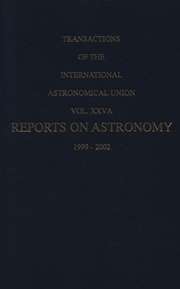No CrossRef data available.
Article contents
Commission 42: Close Binary Stars: (Etoiles Doubles Serrees)
Published online by Cambridge University Press: 25 April 2016
Extract
This is the last triennial report of Commission 42 for this millennium. A great deal has been accomplished in the study of Close Binary Stars (CBS) since the discovery of the first close (eclipsing) binary, Algol, in 1783 by John Goodricke. Now, over 10,000 CBS (most eclipsing variables) are known. More than 5000 of these CBS were discovered over the last several years alone! And many more are expected to be detected over the next few years. Most of these stars were found as spin-offs of microlensing surveys. Interestingly, nearly half of these stars are found outside our Galaxy, primarily in the Magellanic Clouds and M31. Every type of star is represented as a member of a close binary. These include main sequence (as well as pre-main sequence) stars, giants, and supergiants, with the entire possible range of of spectral types and masses represented. Moreover, “dying” stars and “dead” stars, such as white dwarfs, neutron stars, black holes, and, more recently, even brown dwarfs and giant planets (e.g., 51 Peg) have been found as members of close binary systems.
- Type
- Divisions and their Commissions
- Information
- Transactions of the International Astronomical Union , Volume 24 , Issue 1: Reports on Astronomy , 2000 , pp. 259 - 276
- Copyright
- Copyright © Astronomical Society of Pacific 2000




